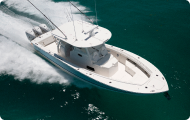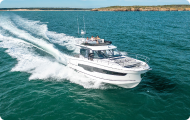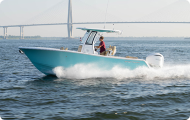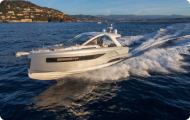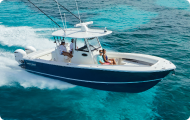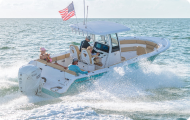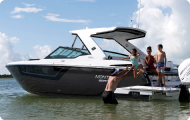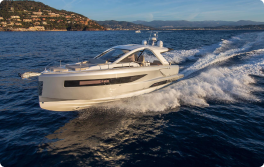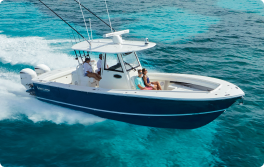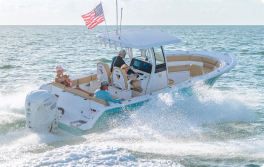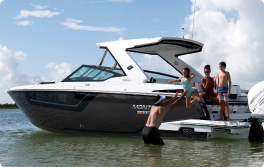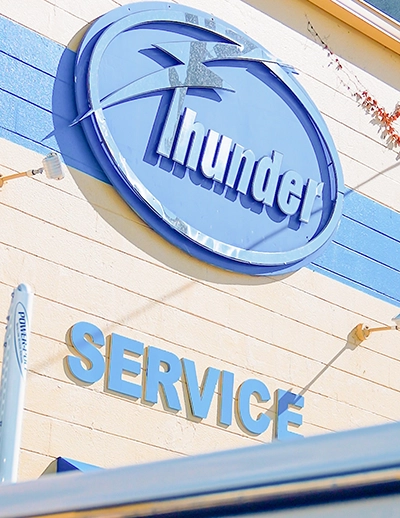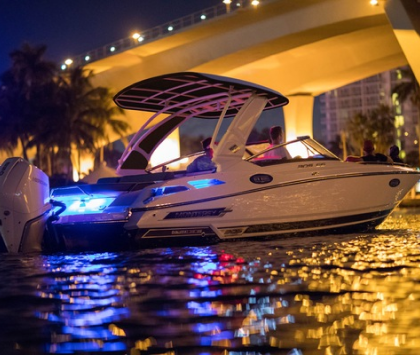Most powerboat drivers just open the throttle and go when they get out to sea. However, one of the most important things to work on is getting the trim of the boat right if you want to get the best out of your boating. You can have quite a lot of scope trimming the boat in a fore and aft direction and getting it right can have a considerable effect of the speed of the boat, the fuel consumption and possibly most important of all, the ride comfort. Getting the trim adjusted correctly is one of the most important driving skills but as far as we can see, few drivers take the trouble to get it right.
Getting the boat on trim improves speed, fuel consumption and ride comfort.
For adjusting the trim, the traditional means of adjustment system is the flaps or trim tabs as they are sometimes called. These are adjustable flaps attached to the bottom of the transom and their angle in relation to the transom can be controlled by means of dashboard switches which in turn operate hydraulic or electric systems to change the flap angle. In their retracted position the flaps are level with the bottom of the hull and have no effect on the trim but when you lower them, they will generate lift at the stern, which in turn will lower the bow.
Trim tabs are adjustable flaps attached to the bottom of the transom.
Interceptor System
A more recent development is an interceptor system. This comprises a vertical plate attached to the transom which can be raised or lowered so that its bottom edge protrudes just below the transom. Like flaps, this small vertical edge protruding below the transom generates lift, allowing a trim adjustment. It is claimed that the interceptors have less drag than flaps and generate more lift.
Interceptors make use of a vertical plate attached to the transom to generate lift. – Imtra Learning Center
Quite a bit of trim adjustment is possible, certainly on planing powerboats, but trim adjustment can also help with semi-displacement boats and to a limited extent with slower displacement hulls. With the latter, the low speed of the boat will not make any trimming device very effective but on trials, I have seen a significant effect on fuel consumption and ride comfort with a displacement hull with flaps.
Most of the trim adjustments will be to control the fore and aft trim but the flaps can also be used for transverse trim. Lower just one flap and this will create lift on the lowered side, which will cause that side of the boat to lift. This transverse adjustment is perhaps the easiest to understand and you will often find that a deep-vee hull on a powerboat will tend to heel into the wind when it is on the plane and the wind is on the beam. This heeling is caused by the wind blowing the bow away downwind, which in turn means that you adjust the steering to counteract this. That steering adjustment causes the boat to heel into the wind.
By lowering the flap on the side into which the hull is leaning you can bring the boat level again and the boat will run more efficiently. but Of course, the drag developed by the lowered flap will also affect the steering and you will need to compensate for this by running with a slight angle on the rudder as well.
As far as the longitudinal trim is concerned, the hull should ride at its best angle in calm water without any flaps being used, assuming that the designer his got his sums right. You can soon check this because if you lower the flaps and the engine rpm increases without touching the throttle. This indicates that the hull is riding more efficiently at this new setting and a small amount of flap may be needed to get the best performance.
Lowering the Flaps
Normally, lowering the flaps in this way will slow the boat down marginally and that is a good sign. The engine rpm figure is a good guide as to whether the hull is riding at its most efficient angle of trim, but the fuel consumption figure shown on most engine displays is also a guide, the lower the consumption for the same speed the more efficient the boat operation.
Boaters need to experiment to get the right setting for the flaps.
You will often find that you will get a much better ride in head seas when you put the flaps down. Lowering the flaps will lower the bow and prevent it rising and falling so much in the waves to give a more level ride. This effect can be quite noticeable, but you will need to experiment to get the right setting. Too much flap and the hull will start to generate a lot of spray, too little and the ride will be lively. In following seas, always run with the flaps up to keep the bow up as much as possible.
Another adjustment found on powerboats fitted with outboards or sterndrives is the power trim. Here, the dashboard controls will cause the sterndrive leg to move in or out in relation to the transom. This, in turn, will cause a small alteration in the angle of the propeller shaft. Moving the drive leg out will cause the bow to rise slightly and bringing it in will cause the bow to dip but these trim changes are much smaller than those found when using the flaps.
With power trim, dashboard controls cause the stern drive leg to move in and out.
Propeller Efficiency
The main reason for trimming the drive leg out in this fashion is to get the best efficiency from the propeller. When operating the boat at slower speeds or when turning, the leg should be trimmed right in to reduce the chance of propeller cavitation. To find the optimum setting for the power trim, run the boat in a calm sea at full speed and notice where the trim is set when the speed reaches its highest point at full throttle.
This should be very close to the best setting, but you might set it a bit lower when the speed is less than the maximum. You also get this sort of power trim on boats with surface drives such as the Arneson, where you can raise and lower the propeller. This is primarily to get the propeller operating at its most efficient depth in the water, but it can also be used to a certain extent to trim the boat.
By using flaps and power trim you can get your boat to run more efficiently in calm seas and more effectively in rough seas. At speeds above 40 knots, these trim controls become more effective and they can have a significant effect on the way the boat behaves in rough seas, changing a rough ride into a controlled ride.
Interceptor vs. Flaps
The modern interceptor systems are very fast-acting when compared with flaps. With flaps, you tend to find the best adjustment and then leave the setting alone. Modern interceptors have a response time of around half a second. This means that they can be used for an automatic system where the longitudinal trim of the boat is constantly being adjusted to match the movement of the boat in waves.
Interceptors have a faster response time when compared with flaps.
I did some trials with the Swedish Humphree interceptor system in very lively seas in the Baltic and the result was quite dramatic. The waves were around 5 feet high and we were out in a fast 35-footer. With waves that high it was a case of constantly using the throttle to try and match the speed of the boat to the oncoming waves.
Humphree Automatic Trim Control
Switch on the automatic trim control system and suddenly it was like a magic carpet ride with the pitching greatly reduced and the boat automatically adjusting the trim to the movements of the boat. I estimated that the pitching movements of the hull were halved, making life on board much more comfortable. We were also able to maintain a higher speed in the conditions with manual control.
This automatic system also kept the boat more or less upright, making a great deal of difference to the ride comfort. Anyone who has driven a deep-vee hull close to its limits will know that if the boat lands in waves when it is heeled over then you can get a considerable impact because the vee of the hull that should cushion the impact is now a flat surface when it impacts with the water. That can cause a big bang and much discomfort. Keeping the boat upright makes a huge difference.
Semi-Displacement Hulls
We have all seen the semi-displacement hulls of Downeast style of boat riding at speed with its bow up in the air. This is an angle where the hull is not working at its best efficiency. If you can trim that bow down a bit, then the fuel consumption will drop with little or no loss in speed. This has led to the thinking that perhaps the center of gravity of the hull should be moved a bit further forward. That has a beneficial effect not only in reducing the fuel consumption but also in reducing the pitching motions of the hull and the heavier bow is less prone to pitching.
Trim tab adjustment can improve the performance of semi-displacement hulls.
We have seen how the automatic trim control systems can give you a more comfortable ride and reduce the pitching but as the driver of the boat you also have a hand-controlled rapid trim response and that is in the throttles. Notice how the bow of the boat lifts when you open the throttles and drops when you close them. This is short term trim control and you can see offshore racing powerboat drivers using this to good effect when trying to maintain the highest speeds in the rough. It does require intense concentration and an engine that will give an instant response to throttle settings, but it is another form of trim control.
I am sure the time will come when you will have a computer in control and all the trimming will be done automatically to optimize the boat for maximum economy and/or maximum comfort or hopefully both. In the meantime, there is a lot you can do to both improve the ride and improve the performance just by optimizing the trim of the boat.


